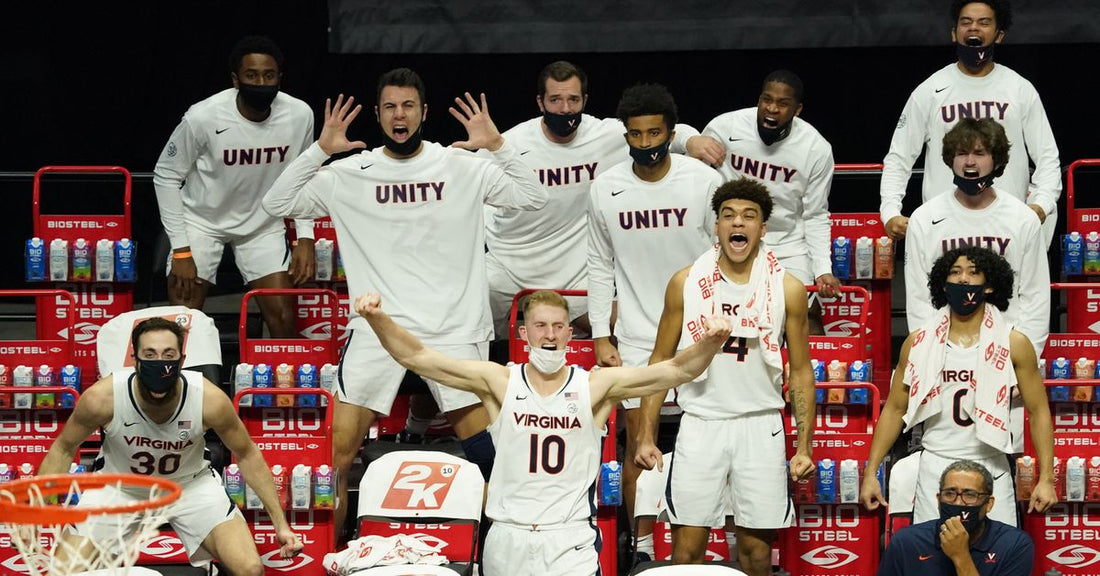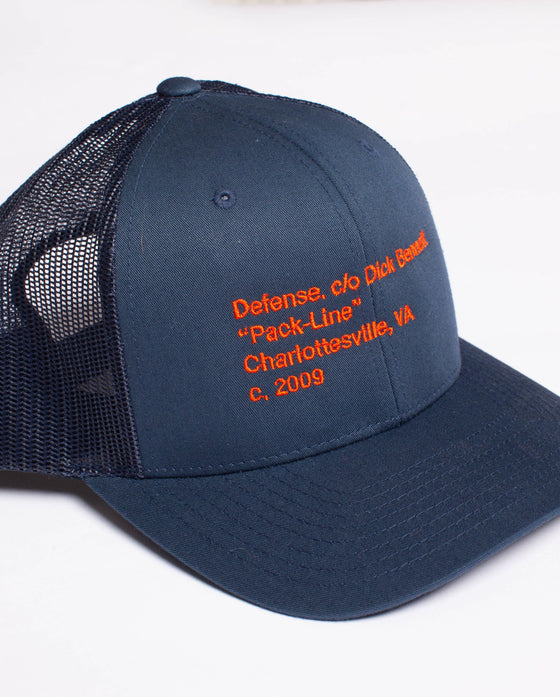What Is UVA's Offense This Season?

(Image - David Butler - USA Today)
In two games so far this season, we’ve witnessed two incredibly different offensive performances. In game one against Towson, the Wahoos scored 89 points and put up a ridiculous 1.44 points per possession. Two days later against San Francisco, they put up 60 points while scoring a measly 0.95 points per possession. These two apparent outliers in offensive efficiency beg the question: What is going on with Virginia’s offense?

What is this new five out set?
The offensive talent on this year’s squad is unlike any other in Tony Bennett’s coaching career. Jay Huff is a legit stretch five who is continuing to establish a presence in the post. Sam Hauser is a deadly shooter as an offensively versatile wing. Trey Murphy is a bouncy 6’9” with a pure shooting stroke and burgeoning athleticism. Those three make up what is a very odd offensive front court for Tony Bennett and his staff to work with. Obviously, there’s significant talent there and more talent is better than less. But it’s apparent that they’ve never really built an offense around a group of guys like this.
So, this offseason, Bennett and his staff went about building an offensive scheme that would cater to the strengths of those three guys and revamp an offensive system that has been reliant on specific roles. What they came up with? A five-out, motion offense modeled off of division-three school St. Joseph’s offense.
This offense’s most basic purpose is to play position-less basketball and allow wings like Murphy and Hauser to solely play on the perimeter while also spreading the floor with their shooting ability. This is in stark contrast to Bennett’s past offensive schemes which divided players into either big men -- who worked as screeners -- and guards -- who attacked off those screens.
This set is predicated on quick ball movement and tons of off ball cutting to open driving lanes and effectively spread the floor. There are meant to be two players occupying the interior of the defense while two others occupy the perimeter adjacent to the ball handler. Once the ball handler passes the ball, his job is to either cut through and clear out or set an off ball screen for the player adjacent to him and allow him to curl and cut to the hoop. There are also constant backdoor cuts as, when a player dribbles towards another guy adjacent to him, that adjacent man must cut backdoor.
There’s also meant to be as little actual dribbling as possible. With quick enough ball movement from side to side, there are always two guys cutting and two guys extending out to the perimeter from where they were on the baseline or in the paint. It’s a constant motion that relies on effective drives to basket and spacing from three-point shooters. When the ball is moving quickly, there are opportunities for players to attack off the dribble and penetrate the defense. From there, they’ll have options to kick out to teammates at the three-point line or, if the floor has stayed spaced enough, finish at the rim.
There’s also an isolation/high post option built into this offense where one side of the court is cleared out for one player -- guard or big -- who is fed the ball in the high, wide post. That player can either face up and drive to the rim or back their opponent down and truly post up. Either way, the off ball motion for the players on the opposite side is a rotation towards the ball as the closest player back-cuts his man towards the basket and the other three fan out around the arc.
You’ll notice, there are near to no actual ball screens incorporated into this set as they’re considered to only slow down the motion and clutter the driving lanes. Additionally, off ball screens are rare and only meant to create space.
This offense is meant to produce layups and three-pointers and cut down on midrange looks unless in isolation. It’s a massive attempt at a modernization of the UVA offense and is the most extreme example of Bennett trusting his players to go out and make plays. With this offense he’s giving up control and making a sharp turn away from the scripted continuity based sets that have been the staples of his system for so long.
How well has it worked?
Through two games, we’ve seen both the wonders and the warts of this scheme as Virginia has used this set on 78% of their settled offensive possessions against man defense. It worked wonders against Towson. On 34 possessions, the ‘Hoos scored 46 points for an impressive 1.35 points per possession. The ball movement that game was rapid and there was a consistent hum to the offense all game long. But, then, on Friday, the Wahoos came crashing back to earth with only 32 points on 37 possessions for 0.86 points per possession.
So, what changed? First off, Towson has a bad defense and had no idea that this revamped offense was coming. Virginia ran circles around already easily-confused defenders who were just completely dumbfounded by this new set. That, and the fact that they clearly didn’t scout Trey Murphy, largely contributed to that impressive offensive output. UVA still played very well, but all the hype surrounding the new offense was obviously very premature coming out of Wednesday’s win.
Against San Francisco, Virginia was sluggish out of the gate and struggled to move the ball with the same crispness as Wednesday. The Dons utilized their athleticism -- significantly superior to Towson’s -- to press out on the perimeter, rarely help on drives, and prevent Hauser, Huff, and Murphy from getting clean looks from behind the arc. They decided to force those guys and the Virginia guards to beat them by attacking the lanes created by the stretched floor. Unfortunately for the ‘Hoos, that strategy worked perfectly and exploited their deficiencies as they struggled to penetrate and, when they did, had real trouble scoring at the rim.
The one part of that offense that still worked well against San Francisco was the high post isolation. On 9 possessions with those isolations Virginia scored 10 points for 1.11 PPP. They went to Hauser there five times and then to McKoy and Clark twice.
What now?
With only two games of this new offense, it’s hard to draw any broad conclusions. But, what is clear at this point is that this set isn’t going to be used in 78% of offensive possessions for the rest of the season. There needs to be more of Bennett’s traditional sets incorporated to give the Virginia guards help off the dribble because none of them are athletic or skilled enough to consistently win off the dribble without ball screen assistance.
Kihei Clark struggles to create separation because defenders can recover and contest his shot because of his diminutive size. He also tends to appear lost once he gets into the paint. Casey Morsell has a one track mind to get to the hoop but he lacks the height and skill to finish well. Tomas Woldetensae is actually a decent passer off drives, but only can do so when someone is closing out hard. Kody Stattmann lacks the quickness to get by anyone. Reece Beekman has been decent off the bounce but he hasn’t proven himself as a consistent scorer in that role. Frankly, Trey Murphy might be these team’s best hope as a slasher, but he still needs to add strength and a bit more burst to be that guy. And, lastly, Sam Hauser lacks the quickness to beat guys off the dribble and is poor at absorbing contact at the rim
This is not meant to be a criticism of these players. Rather, it is a criticism of the reliance on an offensive scheme that doesn’t fit well with UVA’s personnel. Sure, spacing the floor and putting Hauser, Murphy, and Huff on the perimeter is a good thing. But running this offense 78% of the time down the floor won’t be conducive to winning basketball for this squad.
What does need to be utilized more from this offensive scheme is the isolation play design in which they’ve scored 1.09 points per possession. This team does have a number of players who can win one-on-one matchups from that high-post/wing area and Bennett should keep going back to that with Sam Hauser. Additionally, through two games, Huff has only been used in that role twice, but he’s someone who can be another matchup nightmare from that position. In fact, in those two possessions, UVA scored four points off of Huff’s play in the post. Obviously that’s a minute sample size, but it indicates that Bennett ought to feed the big man.
What else would work?
Of Bennett’s more traditional offenses, mover blocker -- or sides -- has been used on 13.2% of Virginia’s settled offensive possessions against man defense, while the top-of-the-key ball screen set has taken up 8.7% of those possessions. Notably absent is the continuity ball screen that originally modernized Bennett’s offense in 2018. That is likely due to CBS architect Kirk Penney leaving the coaching staff and returning to New Zealand this summer. Without his influence on Bennett’s schemes, it appears that early this season they’ve given up on that ball screen centric offense which, frankly, is a shame because these wings and bigs could potentially thrive in such an offensive scheme.
Against San Francisco, the high ball screen set yielded 1.17 points per possession. This is a set that Virginia ought to rely on more. Clark is at his best attacking off of a high ball screen. Huff is fantastic as a screener and then utilizes his height, length, and impressive finishing ability to be an effective roller off screens while his shooting ability allows him to be efficient as a pick and popper. Additionally, with both Hauser and Murphy waiting out on the perimeter, defenses will be hesitant to collapse on Clark as he comes off the screen. Beekman can also run the point in that set and gives the ‘Hoos another look there.
Mover Blocker has been oddly ineffective for this team. Against Towson, the ‘Hoos put up a ridiculous 2.0 PPP on five possessions. But, that was more Towson’s inability to guard off ball screens and lack of scouting of Trey Murphy -- who hit three three-pointers off of mover blocker -- than it was anything UVA was doing. In fact, against San Francisco, Virginia didn’t score a single point off seven mover blocker possessions. That is a result of likely less practice time being devoted to an offensive scheme that requires a decent amount of experience and understanding to be effective. Against San Francisco, the pin down and flare screens were sloppy at best as the inexperienced UVA frontcourt struggled to create meaningful space for the Wahoo guards. Additionally the passes between movers were consistently errant and poorly judged.
Realistically, sides should be an offense that suits this team because they’ve got the big men who can force their defenders to stick with them because of their shooting ability. Hopefully, with more usage, this set will yield more positive results like that against Towson.
All in all, offensive innovation is a good thing for this program. Heck, offensive innovation arguably won the National Championship in 2019. But, just because this roster is constructed a bit differently than past teams, that doesn’t mean that the old schemes are now obsolete. Instead, they should be running and incorporating all these different sets and schemes because there’s value in all of them and having more options on the offensive side of the ball is always superior to being limited. It’s honestly exciting that Bennett has taken such a dramatic leap towards a modern offense. But he and his staff shouldn’t ditch the schemes that brung 'em.


